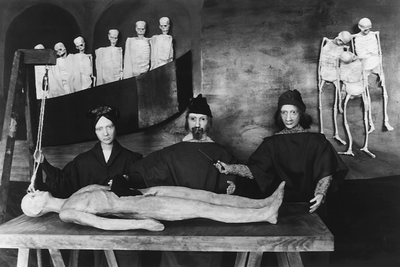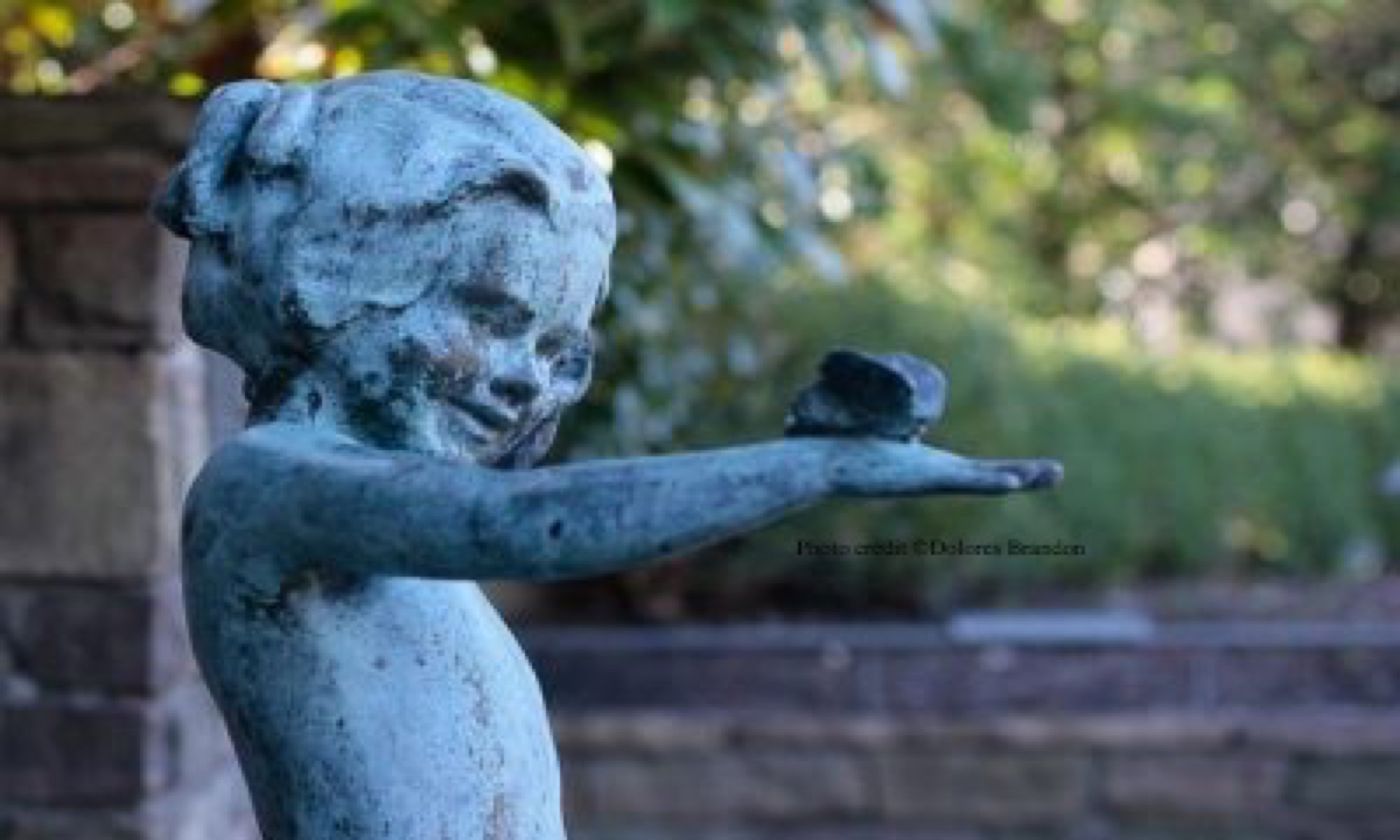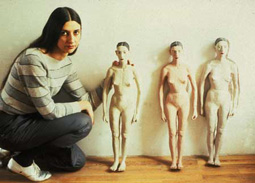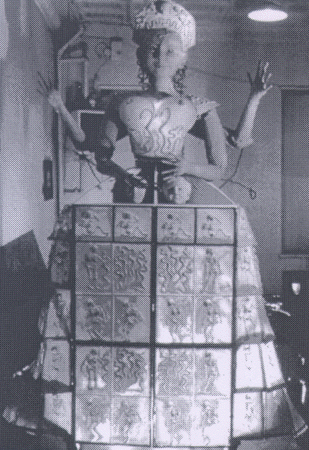UNDER THE KNIFE 3 (1996)
The decades-long AIDS crisis and its devastating impact on her “personal arts community” reawakened in Skipitares a life-long fascination with medicine, which in turn prompted her to write, produce and direct Under the Knife – a theatricalized history of important moments in medical history.
“In 1993 medicine and health were becoming a part of everybody’s daily thinking: friends were caring for very sick people at home with all this medical paraphernalia around the living room. People were worried about what health meant and what health insurance meant.
What interested me as I created this work is the ongoing human desire to heal and the sort of horrible power that comes with it: that and the abuse of that power.”
The following radio feature was produced for Artbeat and distributed by NPR in 1996. Included are clips from my interview with Theodora Skipitares, comments by Martha Wilson (artist, founder Franklin Furnace) and audio recorded during a live performance of Under the Knife 3 as presented at La Mama, New York, NY.
In her own words:
Highlights excerpted from an extended interview with Theodora Skipitares focus on the influences that shaped her career in theater.
Dolores Brandon (DB): Tell me how you came to work with so many different puppet styles and techniques?
Theodora Skipitares (TS): If you talk to a lot of people who work seriously with puppets today, you’ll find that many of them were interested and working with puppets as children; [as artists]they just gravitated toward them. That isn’t me at all. I was making solo [performance art] works in galleries and in performance spaces that had nothing to do with puppetry. They were stories of my life with objects and masks that I made and wore. The puppets that I currently make still come from a mold that is a self-portrait. I think my process in moving to puppets was another kind of mask; it slowly [took over] as I was leaving the stage, as I was leaving the performance arena.
I still wanted me to be there on stage even though I felt I needed to move into the audience to direct and shape the work. So, I made sure there were plenty of surrogate me’s, surrogate Theodora’s. There still are. They could be animals, men, women, whatever, but they still bear a likeness to me, and I think that’s still my autobiographical impulse up there – although I am no longer interested in telling autobiographical stories.
I’m a very three dimensional artist, so I don’t work in two dimensional techniques much and I don’t use shadow puppetry very often. When I first started working with figures, it wasn’t at all important for me to call them puppets; they were simply little figures. And at first they would hardly move at all: I would take a saw and cut the arm at the elbow and reattach it with a piece of string, and pull on the string. They were really, really elementary and had very little [range of] movement. [Over time] they got more complex.
For Under the Knife we created some larger than life sized figures – the Gyno Gals, for example; they’re kind of their own creation. We devised little pieces of hardware to allow access to their fingers [enabling us] to move them around.
DB: Who are the people you’ve learned from, your influences?
TS: Lee Breuer was doing his Shaggy Dog Animation in the early 80s and I was just knocked out by it: he was the main reason I went to puppetry. {With his work] I saw a very free use of puppets. I saw puppets immersed in a whole other brew of multi-media techniques. So, he’s one person. There were a couple of visual artists at the time who were uncharacteristically doing work with puppets – Dennis Oppenheim had a short period of working with puppets, or motorized figures. Then there was a young performer named Winston Tong a Chinese American from San Francisco who came to do a performance at La Mamma; no one knew who he was. I lived around the corner from La Mama as I do now. I remember seeing his piece. Those three influences were very big.
DB: Building the puppets, do you have help?
TS: I do, not a lot of help, usually one key person who works with me for several weeks, and over the years there have been 3-4 really spectacular artists who worked with me: an industrial designer, a sculptor – always one key person working with me with other people helping now and then. Costumes – I always was very good at sewing; it’s the doll part of the puppets that I like.
DB: The combination of puppets and actors: how do you decide which characters will be puppets and which actors?
TS: It’s fairly recent for me to use scenes that are totally inhabited by actors alongside scenes that are totally inhabited by puppets. When I first began working on Under the Knife, (because it was commissioned by the University of Iowa), I began to think in terms of using the acting students there. I stretched my normal way of working because I thought, there are students, graduate and undergraduate acting students here; let me make use of the talent. Up until this production I did work with narrators and singers but they were always employed in the Japanese style: that is, the live performers would be off to one side of the stage while the [actual] stage would be inhabited by puppets. It was different for me to bring actors in.
I had always told myself that puppets were the best conveyors, communicators of innocence: they could tell the most complex story the most innocently. But, when it came to the scene based on Fanny Burney’s letter [describing a mastectomy performed without anesthesia] I simply could not conceive of a puppet up there in any way, shape or form. I knew it had to be an actress. I realized – of course, my goodness one out of nine women has had breast cancer; I will simply look for someone who would like to do the part who has experienced that.
DB: The actress had experienced breast cancer? You thought that was important?
TS: Yes. At the time it did simply because of the numbers – 1 out of 9. It just seemed important to see if there were actresses who were interested in doing the material. I didn’t understand why a puppet didn’t work – I still don’t understand: still, I feel I made the right choice.
DB: The comedic element is very strong throughout UK3.
TS: Yes, I always do have a dark humor in my work, but with UK I included every kind of humor you can think of: medical school humor, cadaver humor. I mean it’s very funny; I think because it’s so close to life and death that there’s a lot of very funny material there – more so than the other subjects I’ve worked with.
DB: I really liked the Dissection scene.
TS: (Laughter) I know, people love to watch puppets do something without text: you can really take in the visual language,which is a very universal language. What’s going on? They’re pulling out these intestines modelled from sewed up panty hose. It does create a kind of horrifying plus hilarious scene.

DB: The puppets do the actual dissection, which is very impressive – such detailed, fine movement is required. This activity plus the voice of an actor [off-stage] talking about his first year of medical school; he describes how he became obsessed with dissection. That scene really does capture both the glory and the horror given the delicious glee with which the medical student describes looking at all the bodies waiting to go ‘under the knife’.
TS: I was enrolled as a pre-med student at Berkeley and well on my way to becoming a doctor when I made a dramatic shift into theater. So, I never did go to medical school and didn’t get into human dissection, going to the morgues etc. But, I understand the fascination.
DB: Under the Knife seems to be quite critical of the methods of Western medical practice. Was that a key note you wanted to sound?
TS: I guess it is a critical work, but I hope it also shows you the complexities of the failures and disasters: the well-meaning, but incorrect assumptions, like the assumption Galen made about women’s sexual organs being exactly like men’s only locked up inside. The fact that that was an important point of view before dissection came back into favor was one thing; but once dissection becomes common practice and you have sophisticated medical illustrators and very skilled dissectors continuing to persist with that point of view – that requires such a powerful prejudice. That kind of blindness is something that interests me a lot. I did a piece in 1987 called DEFENDERS OF THE CODE – a kind of history of genetics and eugenics. At the time Steven J. Gould was a really important resource for me: several of his essays are about that kind of blindness – where a scientist, the supposed center of objectivity, will undertake a study with such a result in their mind that they absolutely sleepwalk through the process of the experiment in order to get the result that they assume will be there.


